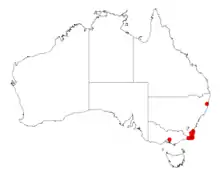Acacia subporosa
Acacia subporosa, also commonly known as river wattle,[1] bower wattle,[2][3] narrow-leaf bower wattle and sticky bower wattle,[4] is a tree or shrub of the genus Acacia and the subgenus Plurinerves that is endemic to an area of south eastern Australia. It is considered to be rare in Victoria[3]
| Acacia subporosa | |
|---|---|
| Scientific classification | |
| Kingdom: | Plantae |
| Clade: | Tracheophytes |
| Clade: | Angiosperms |
| Clade: | Eudicots |
| Clade: | Rosids |
| Order: | Fabales |
| Family: | Fabaceae |
| Clade: | Mimosoideae |
| Genus: | Acacia |
| Species: | A. subporosa |
| Binomial name | |
| Acacia subporosa | |
 | |
| Occurrence data from AVH | |
Description
The tree or shrub typically grow to a height of 4 to 12 m (13 to 39 ft) and has an erect or spreading[1] or rounded habit and a low canopy with a width of around 20 to 30 ft (6.1 to 9.1 m)[2] with weeping branches that have smooth grey or born coloured bark smooth. It has sticky and glabrous branchlets that have green to brown alternating ridges.[1] Like most species of Acacia it has phyllodes rather than true leaves. The thin and glabrous phyllodes have a very narrowly elliptic shape than can be slightly to moderately incurved with a length of 6 to 9 cm (2.4 to 3.5 in) and a width of 4 to 11 mm (0.16 to 0.43 in) and have two to five main nerves per face and other less pronounced longitudinal nerves in between.[4] It blooms between July and October and occasionally into the summertime producing pale yellow flowers.[1] The simple inflorescences occur singly or in groups of up to three in the axils and have spherical flower-heads with a diameter of 6 to 7 mm (0.24 to 0.28 in) containing 20 to 25 flowers. Following flowering firmly chartaceous and glabrous seed pods are formed that are linear with a length of up to 7.5 cm (3.0 in) and contain glossy dark brown seeds with an oblong shape, a length of about 4 mm (0.16 in) and a small terminal aril.[4]
Taxonomy
The species was first formally described by the botanist Ferdinand von Mueller in 1863 as a part of the work Fragmenta Phytographiae Australiae ,[5] the initial spelling was Acacia supporosa.[1] It was reclassified as Racosperma subporosum by Leslie Pedley in 2003 then transferred back to genus Acacia in 2006.[5] The type specimen was collected by von Mueller from Twofold bay in New South Wales.[4] The specific epithet is derived from the small oil glands on the phyllodes. The species is closely related to Acacia cognata[1] and both belong to the Acacia verniciflua complex.[4]
Distribution
It is native to coastal areas of south eastern New South Wales and north western Victoria.[1] The range of the plant extends from around Bega in the north to around Howe Hill on the north eastern tip of the Victoria-New South Wales border in the south[4] in the far east Gippsland area.[3] It is commonly situated along creeks and streams in gullies or on low hillsides found near the margins of rainforest communities growing in moist sandy or shale-based soils and conglomerates.[4] It is often associated with Acacia longifolia.[6]
Cultivation
The tree is used as street trees or as a screening plant, it can grow at a rate of about 24 in (610 mm) per annum and live for almost 50 years. The plant is susceptible to root rot and shothole borer.[2]
See also
References
- "Acacia subporosa F.Muell". PlantNet. Royal Botanic Garden, Sydney. Retrieved 14 January 2021.
- "Bower Wattle Acacia subporosa". SelecTree: Tree Detail. Urban Forest Ecosystems Institute. Retrieved 14 January 2021.
- "Acacia subporosa F.Muell. Bower Wattle". VicFlora. Royal Botanic Gardens Victoria. Retrieved 14 January 2021.
- "Acacia subporosa'". Western Australian Herbarium. Retrieved 14 January 2021.
- "Acacia subporosa F.Muell. Bower Wattle". Atlas of Living Australia. Global Biodiversity Information Facility. Retrieved 14 January 2021.
- "Acacia subporosa". Bournda Environmental Education Centre. Retrieved 14 January 2021.